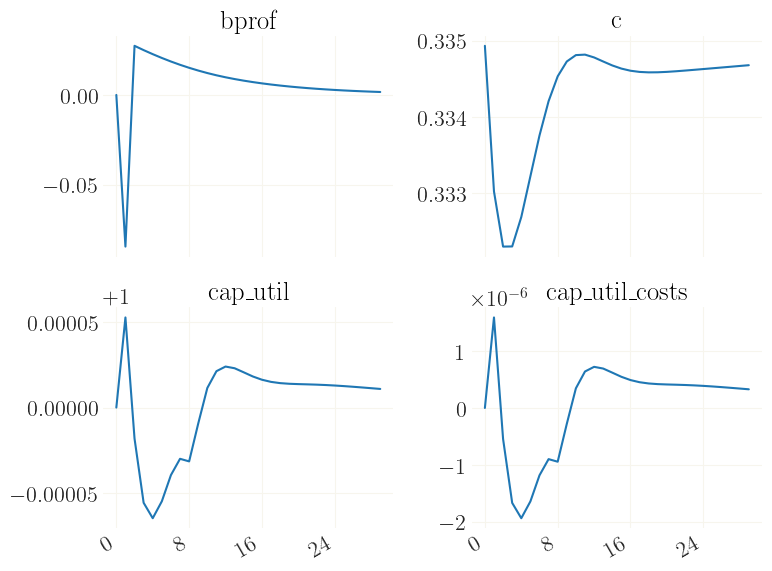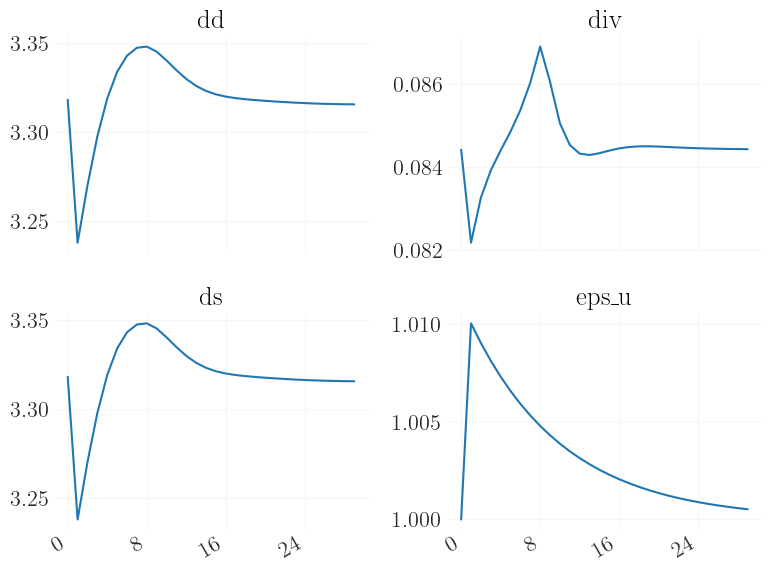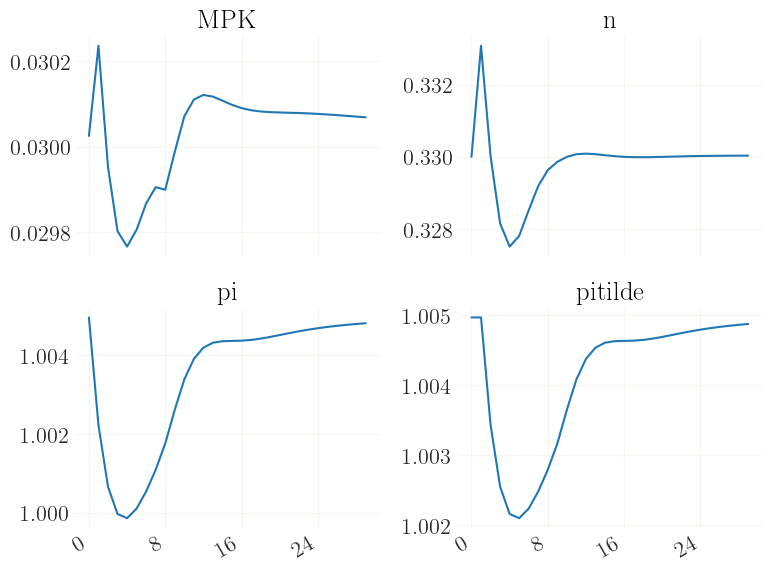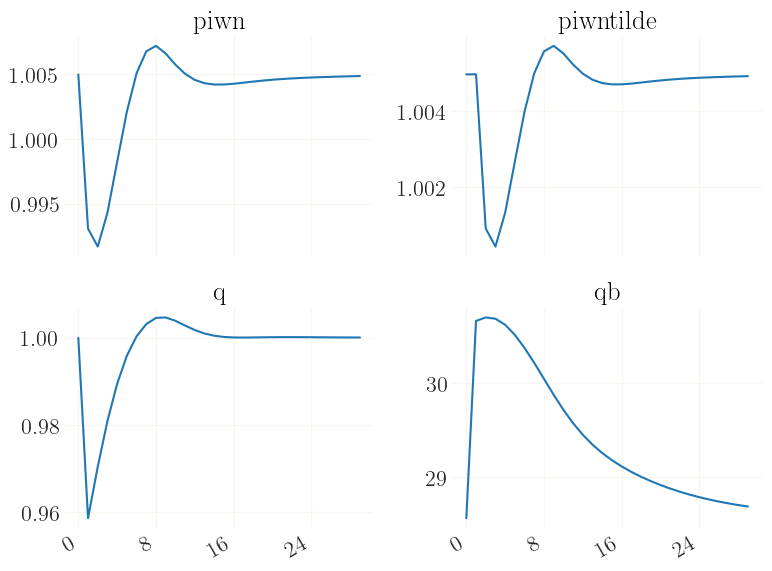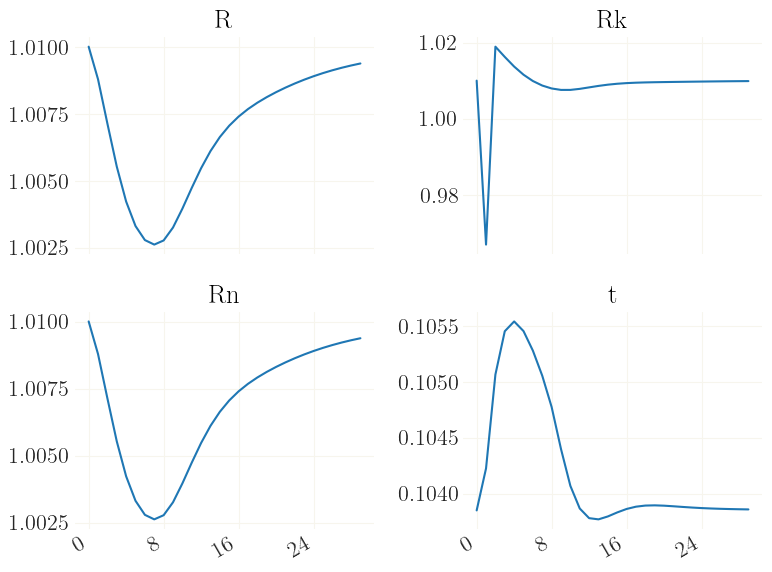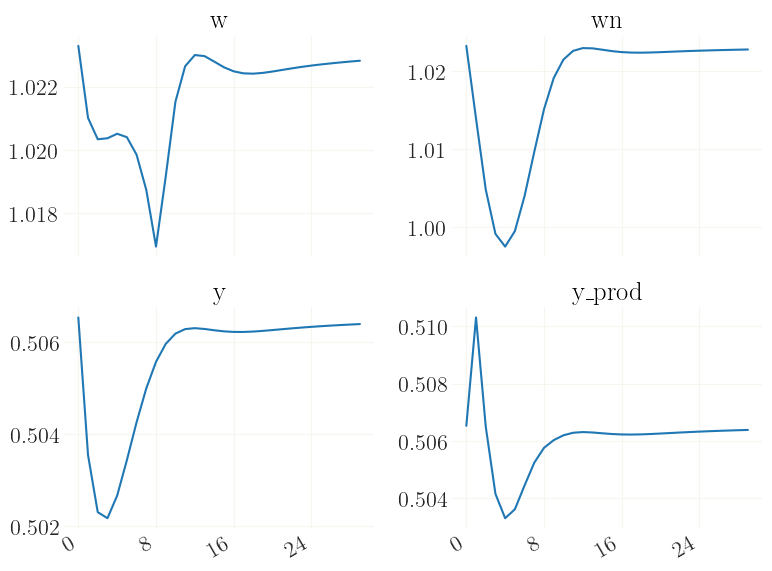RANK Tutorial#
Let us dive a bit deeper into the functionalities of the package by looking at a nonlinear medium scale DSGE model in the style of Smets & Wouters (2003,2007). The model features Rothemberg instead of Calvo pricing, the zero-lower bound on the nominal interest rate, and downwards nominal wage rigidity. The full model specification can be found in the appendix of the original paper, whereas the yaml file can be found here.
Start with some misc imports and load the package. The rest of these tutorials rely on the grgrlib for plotting, which can be installed via the official repositories (”pip install grgrlib”).
[1]:
import jax.numpy as jnp # use jax.numpy instead of normal numpy
from grgrlib import grplot # nice backend for batch plotting with matplotlib
import econpizza as ep # pizza
import matplotlib.pyplot as plt
# only necessary if you run this in a jupyter notebook:
%matplotlib inline
The YAML file called dsge.yml is, together with a few other examples, provided with the package and can be found in this folder.
These examples can be imported from the econpizza.examples submodule.
[2]:
# the path to the example YAML
example_dsge = ep.examples.dsge
This is nothing else than the local path to the YAML file:
[3]:
print(example_dsge)
/home/gboehl/github/econpizza/econpizza/examples/dsge.yml
Let us make use of the functionality to parse the model before loading it, so that we can make some manual adjustments. This is especially useful if we want to loop over different parameter values.
[4]:
model_dict = ep.parse(example_dsge)
model_dict.keys()
[4]:
dict_keys(['name', 'description', 'variables', 'parameters', 'shocks', 'equations', 'steady_state', 'path', 'vars'])
model_dict now contains all information on the model. Let’s, for example, change the sensitivity of the monetary policy rule w.r.t. inflation, and then load the model. Note that I’m loading model_dict instead of the path to the YAML. ep.load would accept both as input, but of course only model_dict contains the changed parameter value.
[5]:
model_dict['steady_state']['fixed_values']['phi_pi'] = 2.
# load the model
mod = ep.load(model_dict)
type(mod)
(load:) Parsing done.
[5]:
econpizza.__init__.PizzaModel
mod is now an instance of the class PizzaModel, which is the generic model class. Note that this still contains the original dictionary together with some compiled information:
[6]:
mod.keys()
[6]:
dict_keys(['name', 'description', 'variables', 'parameters', 'shocks', 'equations', 'steady_state', 'path', 'vars', 'context', 'cache', 'func_strings'])
Lets find the steady state.
[7]:
_ = mod.solve_stst()
Iteration 1 | max. error 1.90e+00 | lapsed 1.5861
Iteration 2 | max. error 2.31e+00 | lapsed 1.6636
Iteration 3 | max. error 9.71e-01 | lapsed 1.6644
Iteration 4 | max. error 1.13e-01 | lapsed 1.6650
Iteration 5 | max. error 4.88e-02 | lapsed 1.6656
Iteration 6 | max. error 1.79e-02 | lapsed 1.6662
Iteration 7 | max. error 4.54e-03 | lapsed 1.6668
Iteration 8 | max. error 4.67e-04 | lapsed 1.6674
Iteration 9 | max. error 6.07e-06 | lapsed 1.6680
(solve_stst:) Steady state found (1.9064s). The solution converged.
Note that the result gets cached and will not be re-evaluated if called again (this can be bypassed by using the force=True flag in solve_stst()).
[8]:
_ = mod.solve_stst()
(solve_stst:) Steady state already known.
…but you could change a parameter or steady state value and reevaluate again:
[9]:
model_dict['steady_state']['fixed_values']['sigma_c'] = 1.5
# load the model
mod = ep.load(model_dict)
newton_dict = mod.solve_stst()
(load:) Parsing done.
Iteration 1 | max. error 1.90e+00 | lapsed 1.4342
Iteration 2 | max. error 2.31e+00 | lapsed 1.4352
Iteration 3 | max. error 9.71e-01 | lapsed 1.4358
Iteration 4 | max. error 1.13e-01 | lapsed 1.4365
Iteration 5 | max. error 4.88e-02 | lapsed 1.4371
Iteration 6 | max. error 1.79e-02 | lapsed 1.4377
Iteration 7 | max. error 4.54e-03 | lapsed 1.4383
Iteration 8 | max. error 4.67e-04 | lapsed 1.4389
Iteration 9 | max. error 6.07e-06 | lapsed 1.4395
(solve_stst:) Steady state found (1.5254s). The solution converged.
Also note that this was much faster thant the first run above, because the function solve_stst() is now cached. This makes it much faster to try out different steady state values.
The object newton_dict contains the results from the Newton-based root finding, which may be interesting for debugging (you must use the raise_errors=False flag to avoid raising an error and to get the dictionary):
[10]:
model_dict_broken = ep.copy(model_dict) # ep.copy is an alias for deepcopy
model_dict_broken['steady_state']['fixed_values']['mc'] = 200. # so wrong!
# load the model
mod = ep.load(model_dict_broken)
newton_dict = mod.solve_stst(raise_errors=False)
(load:) Loading cached model.
Iteration 1 | max. error 1.20e+03 | lapsed 0.0004
Iteration 2 | max. error 1.20e+03 | lapsed 0.0011
Iteration 3 | max. error 1.20e+03 | lapsed 0.0016
Iteration 4 | max. error 1.20e+03 | lapsed 0.0022
Iteration 5 | max. error 1.20e+03 | lapsed 0.0027
Iteration 6 | max. error 1.26e+03 | lapsed 0.0033
Iteration 7 | max. error 1.89e+04 | lapsed 0.0038
Iteration 8 | max. error 2.38e+04 | lapsed 0.0044
Iteration 9 | max. error 1.20e+03 | lapsed 0.0049
Iteration 10 | max. error 1.20e+03 | lapsed 0.0055
Iteration 11 | max. error 1.20e+03 | lapsed 0.0060
Iteration 12 | max. error 1.20e+03 | lapsed 0.0066
Iteration 13 | max. error 1.20e+03 | lapsed 0.0071
Iteration 14 | max. error 1.20e+03 | lapsed 0.0076
(solve_stst:) Steady state FAILED (max. error is 1.20e+03 in eqn. 13). Maximum number of 15 iterations reached.
This failed because marginal costs are a function of the values of theta. While in this case the reason is clear, in other cases you could have a look at the Newton dictionary to debug this:
[11]:
print(newton_dict.keys())
dict_keys(['success', 'message', 'x', 'niter', 'fun', 'jac', 'det', 'initial_values'])
Let us better return to the working model. The model has many shocks. We’ll go for a risk premium shock, e_u.
[12]:
mod = ep.load(model_dict)
_ = mod.solve_stst()
print(mod['shocks'])
# shock the risk premium
shk = ('e_u', .01)
(load:) Loading cached model.
(solve_stst:) Steady state already known.
['e_beta', 'e_z', 'e_g', 'e_p', 'e_w', 'e_i', 'e_r', 'e_u']
Simulation works as before…
[13]:
# find the nonlinear trajectory
x, flag = mod.find_path(shock=shk)
Iteration 1 | max error 2.24e+00 | lapsed 2.3029s
Iteration 2 | max error 7.13e-02 | lapsed 2.3286s
Iteration 3 | max error 3.33e-02 | lapsed 2.3434s
Iteration 4 | max error 3.10e-02 | lapsed 2.3574s
Iteration 5 | max error 2.39e-02 | lapsed 2.3715s
Iteration 6 | max error 1.37e-02 | lapsed 2.3856s
Iteration 7 | max error 2.72e-03 | lapsed 2.3997s
Iteration 8 | max error 1.61e-05 | lapsed 2.4138s
Iteration 9 | max error 6.39e-11 | lapsed 2.4279s
(find_path:) Stacking done (2.596s).
Now x contains the trajectory in response to the shock. Let us plot this. Note that the dynamics are somewhat “twisted” because of the downwards nominal wage rigidigy.
[14]:
_ = grplot(x[:30], labels=mod['variables'])
